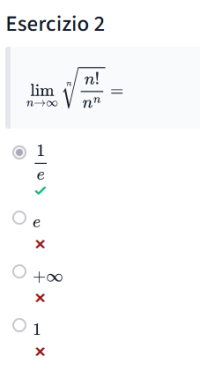You are using an out of date browser. It may not display this or other websites correctly.
You should upgrade or use an alternative browser.
You should upgrade or use an alternative browser.
I have no idea how to solve this: limit, n -> infinity, n-th root of (n! / n^n)
- Thread starter Schairon
- Start date
Dr.Peterson
Elite Member
- Joined
- Nov 12, 2017
- Messages
- 16,619
Interesting problem. I don't immediately see a way to get the limit; can you tell us what topic(s) this exercise is likely to use (that is, what has just been taught, or any other contextual clues)? What theorems or tools do you have available that can be applied to a factorial?Hello everyone, i have no idea how to solve this... i tried everything i know... rewriting the limit as e^log(f(X)) etc. but nothing seems to be working... please i do really need your help.
View attachment 37706
I remember that when I was studying limits that goes to [imath]\infty[/imath], the teacher taught us a way to get rid of the factorial and solve the limit peacefully. She told us to use this technique only when we are really struggling by using all other methods. She hated the students who used this method as the first try. If the OP responds to Dr.Peterson and shows some work, I may reveal my technique.Hello everyone, i have no idea how to solve this... i tried everything i know... rewriting the limit as e^log(f(X)) etc. but nothing seems to be working... please i do really need your help.
View attachment 37706
A message to Dr. Peterson:
Even if the OP did not respond, when the time is right to answer this limit, I would like you to show me how to solve it the hard way. I spent a lot of time to solve it by the squeeze theorem, but could not find the right comparison. I am really struggling. Of course, I have already solved it by using the easy approach. (The secret technique.)
blamocur
Elite Member
- Joined
- Oct 30, 2021
- Messages
- 3,104
I'd look into Stirling's approximation.
This is, in fact, an integral in disguise. To see this, we rewrite as e^(log f(x)), as you call it, and then simplify:
[math] \begin{array}{rcl} \displaystyle \lim_{n \to \infty} \sqrt[n]{\dfrac{n!}{n^n}} &=& \exp\left(\displaystyle\lim_{n\to\infty} \ln\left(\sqrt[n]{\dfrac{n!}{n^n}}\right)\right)\\ &=& \exp\left(\displaystyle\lim_{n\to\infty} \dfrac{1}n\cdot \ln\left(\dfrac1n \cdot \dfrac2n \cdots \dfrac nn\right)\right)\\ &=& \exp\left(\displaystyle \lim_{n\to\infty} \dfrac1n \sum_{k=1}^n \ln\left(\dfrac kn\right)\right) \end{array} [/math](where [imath]\exp(x)[/imath] means [imath]e^x[/imath])
This looks like a Riemann sum. We will write that as an integral then:
[math] \begin{array}{rcl} \displaystyle \lim_{n \to \infty} \sqrt[n]{\dfrac{n!}{n^n}} &=& \exp\left(\displaystyle \int_0^1 \ln(x)\,dx\right) \end{array} [/math]
The rest should be straightforward.
[math] \begin{array}{rcl} \displaystyle \lim_{n \to \infty} \sqrt[n]{\dfrac{n!}{n^n}} &=& \exp\left(\displaystyle\lim_{n\to\infty} \ln\left(\sqrt[n]{\dfrac{n!}{n^n}}\right)\right)\\ &=& \exp\left(\displaystyle\lim_{n\to\infty} \dfrac{1}n\cdot \ln\left(\dfrac1n \cdot \dfrac2n \cdots \dfrac nn\right)\right)\\ &=& \exp\left(\displaystyle \lim_{n\to\infty} \dfrac1n \sum_{k=1}^n \ln\left(\dfrac kn\right)\right) \end{array} [/math](where [imath]\exp(x)[/imath] means [imath]e^x[/imath])
This looks like a Riemann sum. We will write that as an integral then:
[math] \begin{array}{rcl} \displaystyle \lim_{n \to \infty} \sqrt[n]{\dfrac{n!}{n^n}} &=& \exp\left(\displaystyle \int_0^1 \ln(x)\,dx\right) \end{array} [/math]
The rest should be straightforward.
Steven G
Elite Member
- Joined
- Dec 30, 2014
- Messages
- 14,561
Nicely explained.This is, in fact, an integral in disguise. To see this, we rewrite as e^(log f(x)), as you call it, and then simplify:
[math] \begin{array}{rcl} \displaystyle \lim_{n \to \infty} \sqrt[n]{\dfrac{n!}{n^n}} &=& \exp\left(\displaystyle\lim_{n\to\infty} \ln\left(\sqrt[n]{\dfrac{n!}{n^n}}\right)\right)\\ &=& \exp\left(\displaystyle\lim_{n\to\infty} \dfrac{1}n\cdot \ln\left(\dfrac1n \cdot \dfrac2n \cdots \dfrac nn\right)\right)\\ &=& \exp\left(\displaystyle \lim_{n\to\infty} \dfrac1n \sum_{k=1}^n \ln\left(\dfrac kn\right)\right) \end{array} [/math](where [imath]\exp(x)[/imath] means [imath]e^x[/imath])
This looks like a Riemann sum. We will write that as an integral then:
[math] \begin{array}{rcl} \displaystyle \lim_{n \to \infty} \sqrt[n]{\dfrac{n!}{n^n}} &=& \exp\left(\displaystyle \int_0^1 \ln(x)\,dx\right) \end{array} [/math]
The rest should be straightforward.

